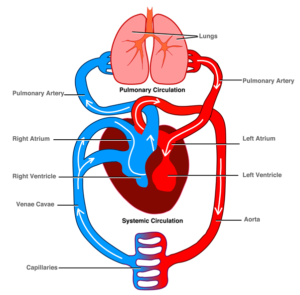Back to: Physical Health Education SS1
Welcome to today’s class!!
We are thrilled to have you in our class!!
In today’s Physical and Health Education class, we will be learning about The Circulatory System
The Circulatory System

In our last class, we looked at the Skeletal System and how the skeletal system is responsible for our movement. And since the human body consists of different systems, we’ll consider what a Circulatory System is. Stay with me!
The Circulatory System, also known as (cardiovascular system) pumps blood from the heart to the lungs to get oxygen. It does not end there. After pumping blood to the heart to the lungs, the heart then sends oxygenated blood through arteries to the rest of the body. The veins carry oxygen-poor blood back to the heart to start the circulation process. Your circulatory system is critical to healthy organs, muscles, and tissues.
The heart and blood vessels make up the circulatory system.
The main function of the circulatory system is to provide oxygen, nutrients, and hormones to muscles, tissues, and organs throughout the body. Another part of the circulatory system is to remove waste from cells and organs so the body can dispose of it.
The heart pumps blood to the body through a network of arteries and veins (blood vessels).
The circulatory system’s function is to move blood throughout the body. This blood circulation keeps organs, muscles, and tissues healthy and working to keep the body alive.
The circulatory system also helps the body get rid of waste products. This waste includes:
- Carbon dioxide from respiration (breathing).
- Other chemical byproducts from your organs.
- Waste from things you eat and drink.
Now, let’s imagine how our Circulatory System works. Let’s take it one after the other.
The circulatory system functions with the help of blood vessels that include arteries, veins, and capillaries. These blood vessels work with your heart and lungs to continuously circulate blood through your body. Here’s how:
- The heart’s bottom right pumping chamber (right ventricle) sends blood that’s low in oxygen (oxygen-poor blood) to the lungs. Blood travels through the pulmonary trunk (the main pulmonary artery).
- Blood cells pick up oxygen in the lungs.
- Pulmonary veins carry the oxygenated blood from the lungs to the heart’s left atrium (upper heart chamber).
- The left atrium sends the oxygenated blood into the left ventricle (lower chamber). This muscular part of the heart pumps blood out to the body through the arteries.
- As it moves through your body and organs, blood collects and drops off nutrients, hormones, and waste products.
- The veins carry deoxygenated blood and carbon dioxide back to the heart, which sends the blood to the lungs.
- Your lungs get rid of the carbon dioxide when you exhale.
In summary, the circulatory system can be the human cardiovascular system. Cardio means heart, and vascular refers to blood vessels.
Evaluation
Explain the functions of the Circulatory System.
Reading Assignment
What aids the functions of the Circulatory System?
Weekend Assignment
Explain how the blood vessels work with the heart and lungs to continuously circulate blood through the body.
We hope you enjoyed today’s class. In our next class, we will discuss the Blood Circulatory System.
Let us know your thoughts and questions in the comment section, and we will attend to them as fast as we can.
